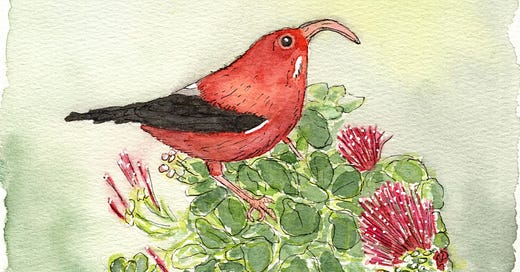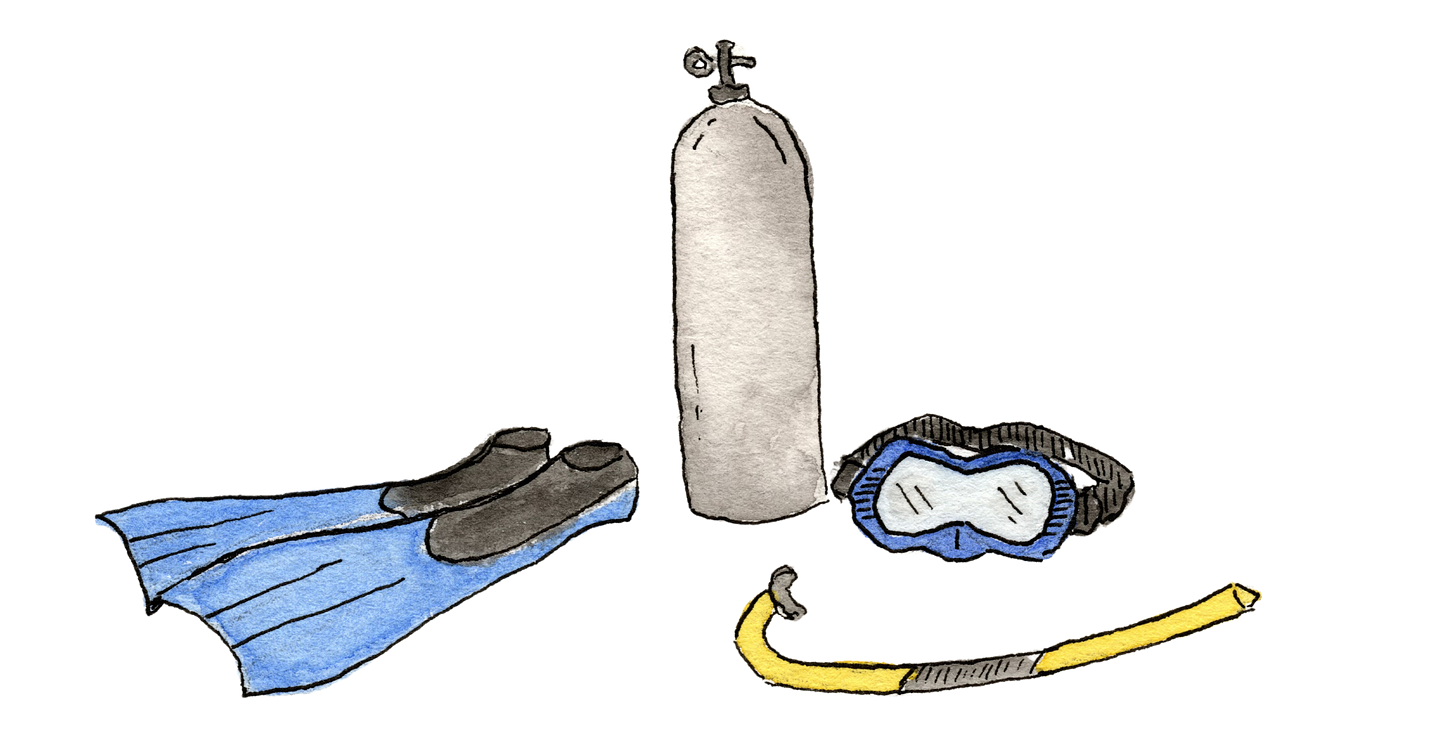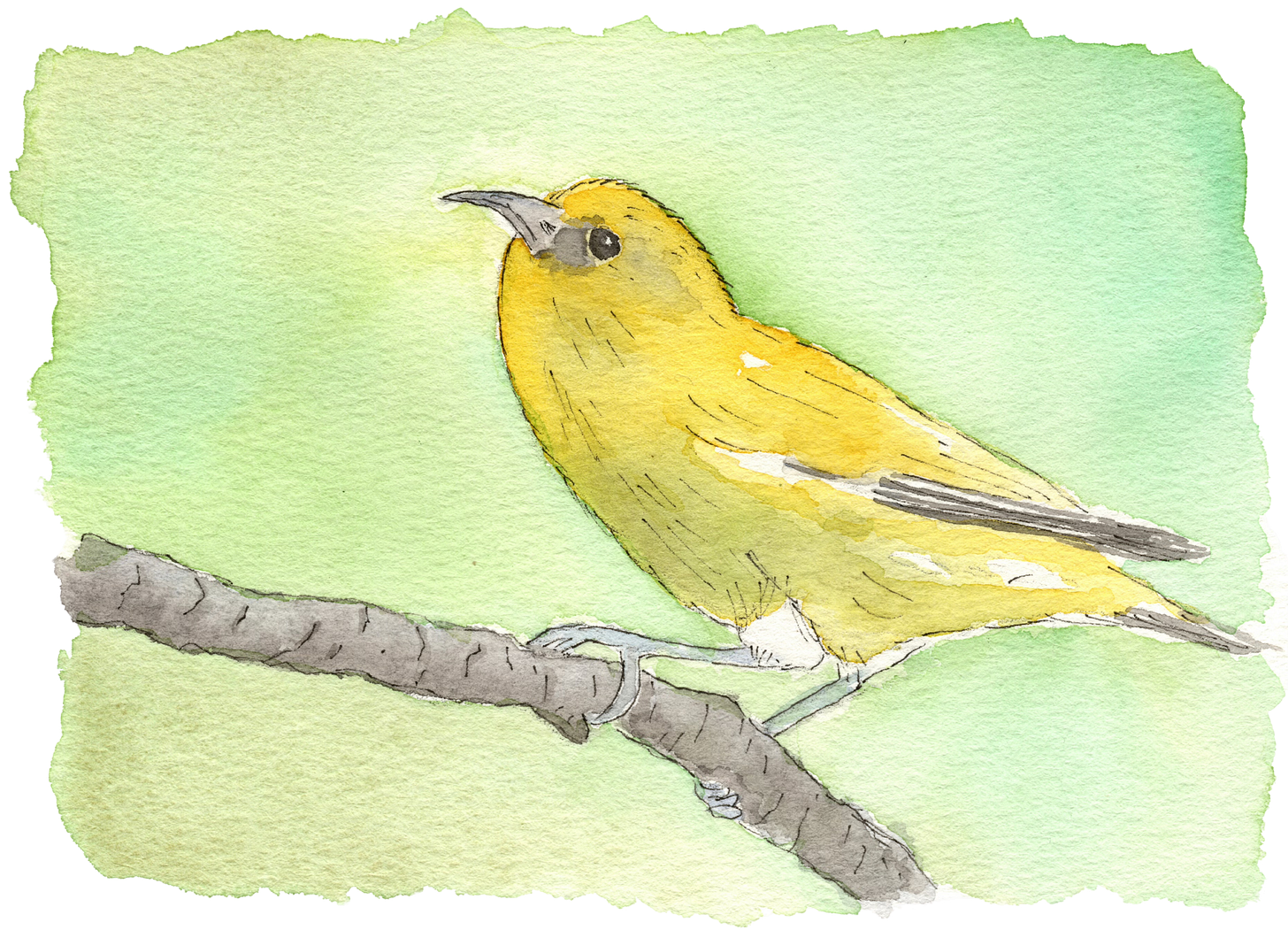Hello! This is The Accidental Birder, an illustrated memoir where travel, birds, and love converge into illustrated essays. If you missed previous chapters, you can find them here. Or start from the beginning here.
I used to roll my eyes at this kind of thing. Then I found myself at 7,000 feet, soaked to the bone, straining through fog for a glimpse of something winged and rare. I was all in—cold, uncomfortable, and oddly thrilled.
“See anything?” I asked Steve.
“Nope. I can hear them, but I can’t make out where they are,” he said.
We sat on the trail, and the damp earth had already done its work. My pants were thoroughly soaked. Drizzle smudged the world into soft edges, and somewhere beyond the low-hanging clouds, birds called, perfectly at ease while I marinated in my own discomfort.
The wavering mist at Haleakalā National Park in Maui played tricks on my vision, as if my pupils had just been dilated. Then, suddenly, the haze thinned. The sun spotlighted the trees, and the landscape finally came into focus—everything unfolding right in front of me. I blinked hard, trying to absorb the transformation. The foliage, once hazy, now etched in sharp detail. But wait! Where are the birds?
Ghostly mist, laced with the scent of eucalyptus, kept teasing us with fleeting moments of clarity before rolling back in. I exhaled, frustrated by the endless game of revelation and erasure. Bird calls wove through the damp air—we could hear them, but still couldn’t see a single one.
I hadn’t expected to care this much. But ever since Steve introduced me to birding, I’d been hooked on the pursuit. The dopamine hit I used to get from shopping—the thrill of slipping into the perfect pair of jeans, or boots that gave me just the right kind of swagger—had been replaced by something entirely different. Now a rush came when a bird I’d been seeking appeared. I’d feel absurdly victorious—like I’d summoned it from hiding, just by wanting it enough.
In the fog, the birds we couldn’t see came alive—and so did the ‘ōhi’a lehua trees. Their fiery red stamens unfurled, releasing a fragrance that drew flashes of wings and quick shadows through the branches. Each time came the chorus—chirps, warbles, and chitters erupting all around us.
Steve scanned the canopy through his binoculars while I kept my camera viewfinder pressed to my eye, ready. It was like trying to follow voices in a blindfolded game—hearing everything and seeing nothing.
For Pete’s sake. Can’t I have both? Flowers to lure the birds and good light to see them?
Some of Hawai‘i’s most remarkable endemics (bird species found nowhere else on Earth) thrive at higher elevations, where they're safe from the scourge of mosquitoes. But across the islands, more than 75% of native bird species have already vanished, many wiped out by avian malaria carried by introduced birds like the Japanese White-eye. Others fell to deforestation, or to predators brought by humans: feral cats, dogs, mongoose, rats. That’s why we found ourselves battling this shroud in the thinning air, keen to glimpse birds that exist only in this fragile corner of the world.
We only had one day. The rest of our time in Maui would be spent scuba diving, and once you dive, high altitude is off-limits for 18 hours, so we couldn’t come back.
We waited, camera and binoculars in hand. It was maddening—at least for me. Steve, on the other hand, was a monument to patience. I was trying to learn that kind of patience, but let’s just say I was a slow study.
That was the heart of birding, though, the very thing that makes it so intoxicating. If it had been easy, I doubt I would have found myself there, straining through the fog, heart set on a glimpse. Legs numb from cold, pants soaked through like some sort of ridiculous sacrifice to the elements.
Here, in a place where so many endemics had already vanished, spotting one would feel like a miracle.
By contrast, we’d had no trouble finding the Nēnē. A pair—each the size of a Canada Goose—lingered near the Park Headquarters Visitor Center, oblivious to their own tenuous history. Reintroduced to Maui by the Boy Scouts in 1962, the Nēnē remains endangered, tagged to track its survival against predators.
Looking for songbirds—like the ‘I’wii (Scarlet Honeycreeper) and the Hawaiian ‘Amakihi—was another story.
The longer we sat there, peering through the mist, I shifted for the tenth time, trying to coax warmth from the silence. I was in Hawai‘i, dressed for a frigid mountain retreat, not the tropics. Bundled in layers, hands wrapped in polar fleece gloves. Cold, damp, and impatient.
The excitement was beginning to wear off. And with it came the uncomfortable thought: maybe my friends were right after all.
When I first started dating Steve, my friends were excited for me. Yet when they saw how deeply I’d embraced the birding life, skepticism crept in.
“You’ve taken on his hobby. What is he changing for you?”
A few said it outright; others, I suspected, felt the same but held back.
I didn’t have an answer. It wasn’t as if I had lost myself entirely. I wasn’t blind to it. Still, it’s not like I sat there thinking, Ugh, why am I wasting my time birding? Truth was, I actually found it kind of, sort of interesting.
Even so, curiosity nagged at me. One day, I asked Steve what he’d picked up since meeting me—something new, something unexpected.
“Jazz,” he said. “I really like jazz now.”
If birding was Steve’s world, jazz was mine. While his library was stacked with field guides, my music library was filled with greats like John Coltrane, Ben Webster, and Duke Ellington.
From the start, I pulled him into my world of jazz. In Scotland, where we first met in person, we had stopped at a bookstore to pick up a map. Toward the back, a small sign simply read Music. I was pulled toward the bins like a needle to vinyl and began flipping through waist-high troughs, thumbing upright CDs stacked like dominoes. In the Jazz section, I plucked the most impossibly romantic albums to soundtrack our Highland road trip. He listened patiently to every track as I held court, arms sweeping, each selection delivered with theatrical flair.
"Christian McBride is the best double bass player since Ray Brown, and Fats Waller had the definitive rendition of Two Sleepy People!"
My words tumbled out in animated bursts, my hands conducting some invisible orchestra as I preached the gospel of jazz. Steve nodded, indulging my fervor.
Over time, thanks to my relentless evangelizing, he got pulled into the world of Diana Krall and Stacey Kent—both of whom we saw multiple times in concert. One day, he casually adjusted the car’s equalizer, tweaking the bass like a man who suddenly had opinions.
After months of absorbing my sermons on Art Tatum and Miles Davis, Steve had become a true jazz disciple. When we weren’t dressed in cargo pants and khaki, we cleaned up well, and Steve was the perfect date for a live jazz performance. Still, I couldn’t shake the gnawing sense of unease that my girlfriends saw something I didn’t.
The life I once had—shopping trips to New York City or Chicago with friends—felt distant, like a past version of myself I could remember but no longer see, swallowed by the fog of something new.
The following day we met a private Dive Master at the shore of a quiet Maui beach. It was Thanksgiving Day, and no one else was around. The sky stretched clear and blue—a welcome contrast to the frustrating weather of the higher elevation. Palm fronds swayed gently, nudged by a subtle breeze. It was a perfect day for the water.
Scuba diving was another adventure Steve had ushered into my life. Though I was still new to it, I had always dived from a boat—either stepping off the stern or, my preferred way, rolling backward into the water from the side. This time, we were shore diving, and I wasn’t exactly sure how to proceed.
Donned in fins and carrying an oxygen tank, I trudged toward the incoming waves. I felt like a toddler in rain boots two sizes too big, stomping sideways into the surf with 35 pounds of pure confusion strapped to my back.
Our Dive Master disappeared beneath the surface.
“Follow him,” Steve said.
“No, you go ahead.”
“I’ll wait. Just to make sure you don’t have any trouble.”
Steve never let me lag too far behind, whether on a trail or in the water. The “No One Left Behind” principle wasn’t just military protocol—it was instinct.
The next big wave surged forward. I surrendered and dove in.
The surf churned up sand, reducing my visibility to just two or three feet. As I swam farther, the sediment began to thin. The water sharpened into clarity revealing tiny, colorful fish darting in and out of view. Steve was beside me now, our Dive Master ahead.
After 30 minutes of gliding over stretches of volcanic rock and sand, weaving through schools of butterflyfish and the occasional darting wrasse, I felt myself settle into the rhythm of the dive. The water was warm, the visibility decent, and Steve stayed close, gesturing toward a pair of moorish idols tracing delicate loops in the current. Then, without warning, a powerful surge caught me, flipping me upside down.
The current kept shoving me in an unknown direction, pushing me somewhere—shallower, maybe. I was too disoriented to know for sure and I couldn’t tell which way was up. Suspended debris clouded the water, reducing everything to a thick, murky blur. My pulse hammered. Panic coiled in my chest, tightening with each useless sweep of my hands. Where is Steve? Where’s the Dive Master?
The rolling current yanked me like a rogue spin cycle, tossing me over and over. The stirred-up sand thickened, closing in. Now I really couldn’t see.
Then, finally, I felt Steve’s hand clasp my arm.
He was right in front of me, but still just a wavering blur.
We knelt on the ocean floor. I glanced at my gauge—nothing. The murky water blurred the numbers, unreadable in the churn of suspended sand. We couldn’t have been too deep. The ocean surged overhead, stirring the current, its movement rippling through me. I had no idea how much air I had left. Though his figure was hazy, it looked like he was motioning for me to clear my mask.
I pressed my fingers against the top of my mask, tilted my head back, and blew forcefully through my nose—pushing the water out. As the fog lifted, Steve’s face sharpened into focus. Steady. Reassuring. My breathing evened out.
I gave him the “okay” sign and followed, moving toward clearer waters.
The current eased, the haze thinned. I was okay. I could see Steve and trust his lead.
The day before, in Haleakalā National Park, the dull gray mist finally lifted after a long, uncertain wait. The air cleared, revealing a world transformed, as if the island had exhaled. Birds emerged, bright and unburdened, their colors vivid against the clearing sky.
First, the crimson and black ‘I‘iwi, its curved bill poised as it surveyed the blossoms. Then, the yellow-green Hawaiʻi ʻAmakihi dipped its beak effortlessly into the cluster of red stamens, drinking nectar like a well-practiced ritual. And finally, the bright olive Japanese White-eye had arrived. Its signature white ring flashed as it flitted between branches. Even though it played a role in the decline of native Hawaiian birds, I still found myself captivated—because it was something new, something unexpected, a piece of the world I hadn’t seen before.
We had laughed, giddy with relief, camera clicking, binoculars raised, absorbing the moment like starved wanderers stumbling upon a feast. After all that waiting, after straining through the haze, the birds had finally emerged. A joyful reminder that even when the world feels clouded, possibility and wonder wait beyond the haze.
Before Steve, birding had never been part of my life, but it would expand my world in ways I hadn’t expected. It taught me to wait, to watch, to embrace stillness before movement—and to understand that a true partnership doesn’t ask you to vanish, but invites you to become more.
At first, my friends weren’t so sure. They saw me immerse myself in birding, leaning into this new world with Steve, and wondered if I was losing myself. As clarity emerged slowly and unpredictably, I realized I hadn’t disappeared at all. What once took up so much space in my life had grown distant, and yet, I didn’t miss it the way I thought I would. Letting go wasn’t losing myself; it was opening up room for what was waiting ahead.















❤️
Jazz and birds is an even tradeoff. What a harrowing adventure under the sea! 😱